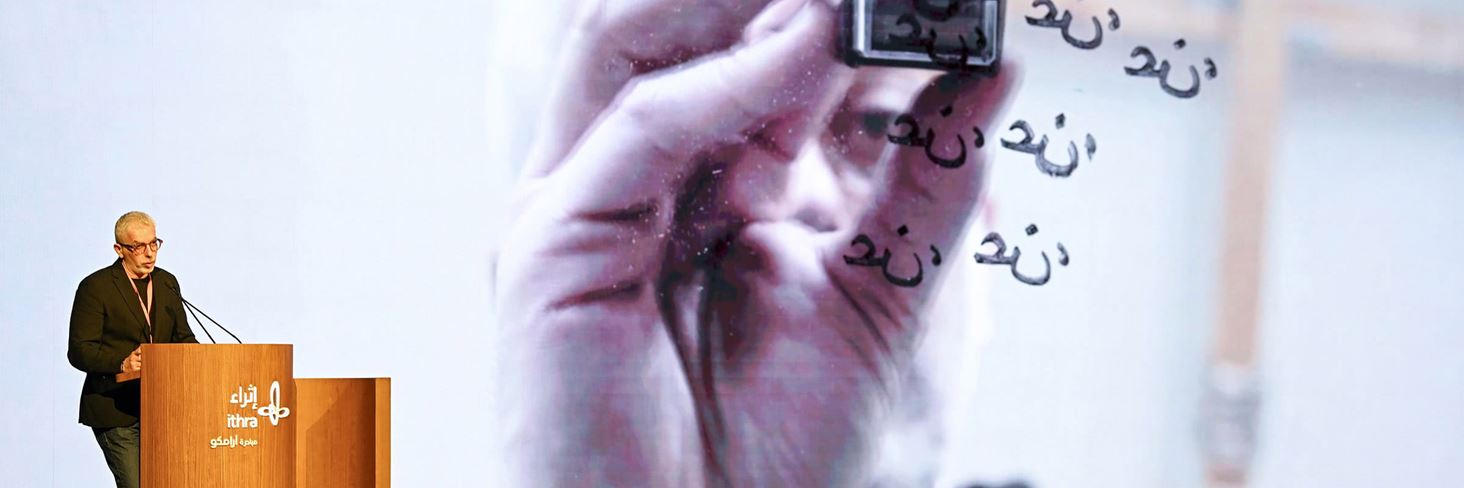
The Past Is Told by the Victors: Exploring the Other Side of History
Art
History
Fertile Crescent
Explore how a narrative of history is dictated by the victors and its affect on our understanding of it.
The following activities and abridged text build off “ Adel Abidin Preserves Historical Memory,” written by Rebecca Anne Proctor.
WARM UP
Explore the concept of history.
IF YOU ONLY HAVE 15 MINUTES ...
Explore how history can be explained from different points of view.
IF YOU ONLY HAVE 30 MINUTES ...
Examine the truthfulness of history.
VISUAL ANALYSIS
Examine how knowing the history behind a piece of art can enhance its understanding.
Adel Abidin Preserves Historical Memory
A large cotton-on-canvas work imbued with abstract figures in Japanese paper and ink takes center stage in the Great Hall of the King Abdulaziz Center for World Culture, also known as Ithra, in Dhahran, Saudi Arabia.


The artwork is delicate and akin to an intricate tapestry. Titled “Aan” in Arabic script, the piece is 400 centimeters X 250 centimeters. Adel Abidin, an Iraqi artist based in Helsinki, Finland, created the mural to tell the tale of the fragility of history. It won the Ithra Art Prize, the largest art grant in the Middle East and North Africa.
The work explores the relationship among history, memory and identity. Abidin’s piece also investigates the ethereal and powerful aspects of oral storytelling of Arab history, which often lacks documentation and is prone to conflicting interpretations.
Abidin was born in Baghdad. Iraq in 1973. He received his bachelor’s degree from the Academy of Fine Arts in 2000. That same year, he left Iraq for Helsinki, Finland. Abidin works in several different mediums including video, sound-based installations, sculpture and painting. His art is considered bold, edgy and thought-provoking, probing differing viewpoints of politics, individual expression and mass-media manipulation.

At first glance, viewers of “Aan” can hardly ascertain what the piece is about. Delving into Muslim history, it portrays the ninth-century Zanj rebellion against the Abbasid caliphate in southern Iraq. The Abbasid was the second of the two great dynasties of the Muslim empire. It succeeded the Umayyad caliphate, which it overthrew in 750 CE. The Abbasid caliphate was destroyed by the Mongol invasion in 1258 CE.
Question: What does the art piece Aan depict?
It portrays the ninth-century Zanj rebellion against the Abbasid caliphate in southern Iraq.

In 869 CE, the Zanj rebelled against the Abbasids to protest their enslavement and austere conditions. They lived in Basra and were forced to drain the region’s salt marshes. The rebellion lasted 15 years.
“History is always told by the victors,” says Abidin. “I am very much interested in history and how history has been written. We never read what the victim has to say.”
In many respects, “Aan” is a way for Abidin to give voice to the victims of the Zanj rebellion. The revolt grew to involve both slaves and freemen and claimed tens of thousands of lives before it was finally crushed.
Question: How is artist Adel Abidin trying to tell the history of the Zanj rebellion differently?
He is giving voice to the victims of the Zanj rebellion.

“History remains alive and constant, but we often don’t know what is true or fiction,” Abidin says. “Many historical events keep repeating themselves. The Zanj rebellion is a revolution against social injustice like many present rebellions in our world today.”
Abidin created otherworldly abstract shapes using thin Japanese rice paper that he layered with glue. This allowed him to construct layers of information forming a visual narrative of the mythical landscape during the Zanj rebellion in Basra. He drew inspiration from the Japanese philosophy of ma, often described as a pause in time. Aan means a moment or a very short time in Arabic.
The resulting image reveals a surreal rendering of the city of Basra and the Tirgis and Euphrates rivers. This aligns with the historic interpretations of the rebellion. Different parts of the work present a different and often contradictory versions of the rebellion’s history and the fallacies of historical interpretation. At the same time, the mural elevates the voices of overlooked groups or individuals and their own histories.
Question:How does the “Aan” tapestry depict different historic interpretations of the Zanj rebellion?
The different layers of the tapestry form different and often contradictory version of the rebellion’s history. It elevates the voices of overlooked groups and their own histories.

The mural is based on one year of research into the Zanj rebellion and aims to capture the fragility of history and question the accuracy of recorded history, at the same time elevating the voices of overlooked groups or individuals and their own histories.
An artwork thus becomes a way of documenting and capturing a lost moment in time and, as Abidin has strived to do, remembering the voices of those who have been defeated and often forgotten.
Like the ever-evolving narrative of history itself, the swirling light-colored forms in “Aan” are meant to both mesmerize and perplex the viewer. As Abidin posits, if history is ambiguous and often shrouded in mystery, then perhaps a work of art holds the key to understanding it with a subjective form of truth, one that is as much based on the facts we know as the facts we have yet to prove and the voices we often have never heard.
Other lessons

Berlin’s International Music Scene: A Study in Migration
Anthropology
Levant
North Africa
Europe
Explore what causes people to leave their homeland and to choose a specific place to settle, and how their presence affects that new place.
The Impact of the Taj Mahal: Analyzing Changed Perceptions
Architecture
Art
History
South Asia
Analyze how 18th-century depictions of the Taj Mahal began changing Western European opinion of India.
Preserving Senegal’s Pirogues: Analyzing and Solving Problems
Environmental Studies
Anthropology
West Africa
Explore how forces of modernity threaten the small-scale fishing that is central to life in Senegal.